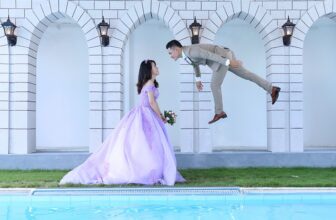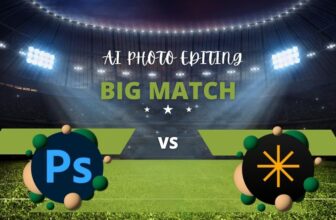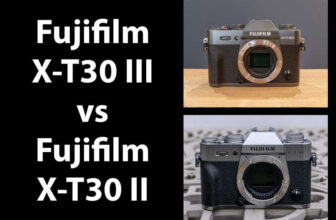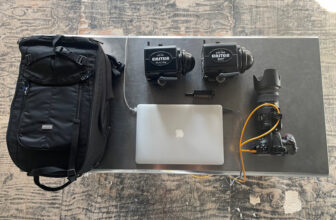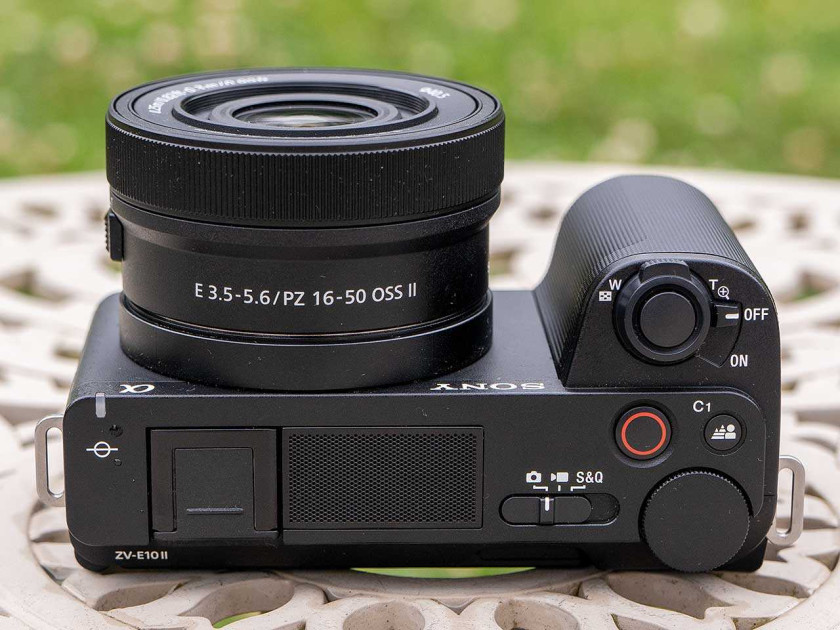
Introduction
The ZV-E10 II is the latest model in Sony’s extensive range of APS-C sensor mirrorless cameras. It replaces the original ZV-E10 that was launched in 2021 and which continues in the range for the foreseeable future.
A glance at the features of the ZVE10 II shows that it shares much of its DNA with the A6xxx series cameras with their APS-C sensors, but it also inherits a lot of key features from the vlogger-friendly ZV-1 series compact cameras.
Sony has cleverly combined the technologies found in both ranges so that this new model places a clear emphasis on video whilst still enjoying the benefits of the larger sensor size.
The Sony ZV-E10 II uses the same 26 megapixel Exmor R backside-illuminated (BSI) CMOS sensor that was employed in the A6700 camera, joined by the latest Bionz XR processor.
It has a native ISO range of 100-32,000, which can be pushed two stops further to ISO 204,800 and drop down to ISO 50 if required.
It can capture 4K/60p video oversampled from 5.6K or 4K/30/25/24p oversampled from 6K, either unstabilized with a modest 1.1x crop or with Active Stabilization with a 1.5x crop. Video can be captured in 10-bit 4:2:2 or 4:2:0 in either H.265 or H.264 AVC files with All-intra compression. It supports S-Log3, S-Cinetone and LUT import, plus in-camera breathing compensation and reduced rolling shutter..
The Slow and Quick motion mode offers 5x slow-motion recording at FHD/120fps quality and 2.5x at 4K/60fps. It has the ability to shoot the same video Picture Profiles as its full-frame A7-series bigger brothers and features 3.5mm mic and headphone ports, an intelligent 3-capsule directional mic and a mini-HDMI port.
The ZV-E10 II has an auto-focus system with 759 phase-detection points and 25 contrast points that cover 94% of the frame, with the system working all the way down to -3EV low-light.
It also offers a fully articulating, vari-angle 1.03-million dot LCD monitor with touchscreen operation and vertical UI support, 11fps burst shooting with continuous AF/AE tracking with the mechanical shutter and 8fps with the silent electronic shutter, 4K/30p and 1080/60p live streaming via the 5Gbps USB-C port, Bluetooth and 5GHz wi-fi connectivity and a single SD UHS-II memory card slot.
The Sony ZV-E10 II is available in black or white, priced at approximately £950 / €1100 / $999 body-only. It’s also offered as a kit with the equally new E PZ 16-50mm F3.5-5.6 OSS II kit lens, priced at approximately £1050 / €1100 / $1099. It is made in Thailand.
Ease of Use

Externally the new Sony ZV-E10 II is extremely similar to the previous ZV-E10 camera, so much so that you’d be hard-pressed to tell them apart side-by-side.
Although they are outwardly very similar, Sony have made a few notable improvements to the new model.
Firstly, the hand-grip on the ZV10II has been made larger and more prominent, predominantly to house the larger NP-FZ100 Z-series battery that has been inherited from the A6700.
This has significantly increased the battery life from 440 shots or 80 mins of video recording on the ZV10 to 610 shots or 130 minutes of video recording on the ZV10 II.
The Mode button on top of the original ZV10, which offered three options – Stills, Video and S&Q (slow-motion video) – has been replaced with a sliding switch that both removes the need to toggle through the three modes and more clearly shows you the currently selected mode at a glance. You still have to dip into the camera’s menu system, though, to select the Aperture Priority or Manual shooting modes, for example.
In addition, the Off/On switch on the original model has now been moved to the right side of the zoom lever/shutter release button, which makes it much easier to turn the camera on and off when using it one-handed.

At just 296g body only, the ZV-E10 II feels disconcertingly light until you fit the battery, memory card and a lens. It measures 114.8 x 67.5 x 54.2mm and weighs in at 379g with the battery and a memory card fitted, making it a little deeper and 36g heavier than the previous version.
It still has a plastic, or polycarbonate, body, which has been chosen to keep the cost of the camera down, but in-hand the body seems solid enough. All the components fit nicely together, there are no creaks or weak looking joints, with everything very well designed and assembled.
The revised hand-grip is much deeper than the original, and still relatively wide and comfortable to hold on to, which combined with the sizable rear thumb rest makes the ZV-E10 II feel secure enough even when shooting one-handed.
The Sony ZV-E10 II still doesn’t incorporate any level of weather sealing for extra peace of mind in more inclement conditions.
One of the main departures from the A6xxx camera range is the omission of an electronic viewfinder in favour of just the vari-angle LCD screen on the rear and a 3-capsule directional mic on the top.
This is obviously a pretty big compromise for stills photographers, less so for vloggers who will be more than happy using just the rear LCD screen to compose.
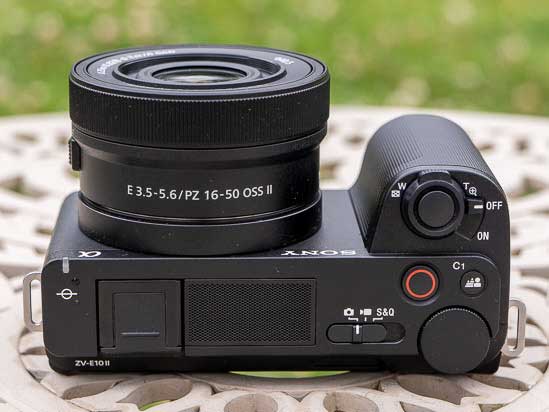
The ZV-E10 II has a higher resolution 1.03-million dot, 3-inch widescreen LCD monitor with a vari-angle design that’s hinged to the side of the camera. It can be flipped out to the side and rotated forwards by 180-degrees, making it perfect for vlogging and selfies. You can also fold it against the back of the camera to help protect it when you just want to carry the camera loose in a bag or pocket.
Sony have also implemented touch sensitivity on the screen, which makes functions like focus point selection much easier and more intuitive, especially given the lack of a rear AF joystick. Thankfully you can finally use the touchscreen to navigate the main menu or quick menu settings, something that the original strangely lacked.
The new version even supports automatic orientation of the user interface when holding the camera vertically as well as horizontally and for both shooting stills and recording video.
Located on the top of the ZVE10 II are a large three-capsule direction microphone and a Multi Interface hot-shoe. The mic has been upgraded to an intelligent design with the addition of an Auto mode to the existing front, rear and all modes.
The shoe allows for any standard accessories to be mounted, with microphones and LED lights being the most obvious. The Multi Interface part allows for compatible to Sony accessories to work intelligently with the camera and also draw power where needed, which means that you can mount and use Sony flashguns. Sony’s range of stereo microphones can also be used, with the audio sent through the Multi Shoe rather than requiring a 3.5mm cable to be plugged into the side of the camera.
The top-plate also sees the continued inclusion of a large video record button. This is large enough to easily find in a hurry and is marked with a red ring to easily identify it against the shutter button.
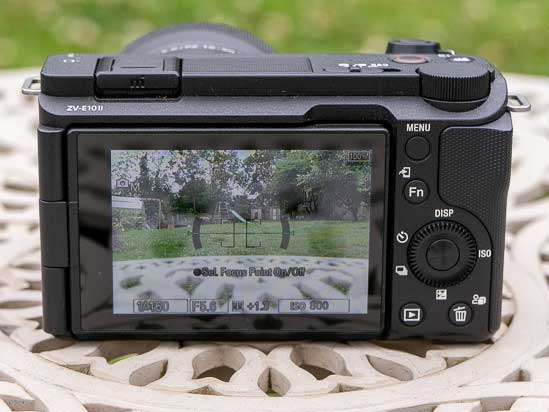
The ZV-E10 II even has a built-in zoom lever which encircles the shutter button. Although it only works with Sony’s Power Zoom lenses, it’s still quite a handy feature to have on such a video-centric camera, providing an alternative to using the zoom ring on the lens itself.
The Sony ZV-E10 II’s main exposure controls are identical to those of its predecessor. There’s the same dual wheel layout with a primary unmarked control dial on the top panel and a secondary rear-panel wheel that doubles up as the 4-way navigation buttons.
It’s a reasonably ergonomic setup, though we’d still prefer an additional control dial positioned near to the shutter release, enabling simultaneous thumb and forefinger settings adjustment.
Finally on top of the camera there is a Background Defocus button. For vloggers the aim of this button is to switch between having the background blurred or clear. In photographic terms it is switching the aperture between the largest available for the attached lens and a stopped down value. It is a useful button to have available for video, but even for photography it is something you could use to make a quick aperture change.
The rear of the camera is identical to the original ZV10, with a familiar directional control dial placed around a central selection button. Around this sit four other buttons to access regularly used features.
The ‘Delete’ button also acts as the ‘C2′ custom button, which by default is set to access the Product Showcase mode. This is an autofocus mode that alerts the camera to switch focus from a person’s face to an object that may be held up in front of the camera.
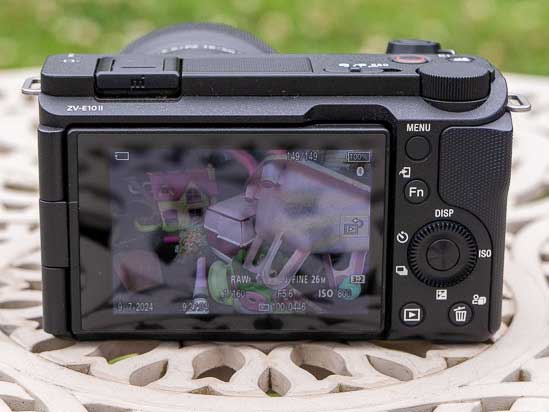
It’s a popular YouTube technique for when wanting to show an item to the viewer, but on cameras with slower autofocus it can leave the focus fixed on the presenter’s face with the product out of focus, and vice versa. The Product Showcase mode solves that issue, adding another plus point for vlogging with the ZV-E10 II.
By default, the Fn button activates the Sony ZV-E10 II’s Send to Smartphone Wi-Fi function when in playback mode. This works in conjunction with Sony’s Imaging Edge Mobile app and lets you transfer a full resolution JPEG image.
Of course, you’ll have to connect your smart device first, but this is a pretty painless process. Sony lets you scan a QR code displayed on the ZV-E10 II’s monitor and this automatically enters the SSID password on your smartphone so you don’t need to type it manually.
A low-power, low-bandwidth Bluetooth 4.1 data connection is available on the ZV-E10 II. This lets you connect your camera to a smart device even when the camera is turned off for easier transfer of images. The Bluetooth connection can also be used to sync GPS location data from your smartphone.
With regards to in-body image stabilisation (IBIS), unfortunately there still isn’t any on this camera. Instead, you’ll have to use a lens with its own built-in stabilization system, such as the E PZ 16-50mm F3.5-5.6 OSS II that we tested the ZV-E10 II with. This will give you a couple of stops extra to play with when taking still images, and it will smooth out the lightest of movements when shooting video.
Failing that, you can also choose to use the camera’s Active SteadyShot mode when recording video (but not stills), which is a digital form of stabilisation. This crops in to the image by 1.5x/1.4x depending on the selected video mode to give the camera the ability to digitally move the image frame around to compensate for any larger movements.
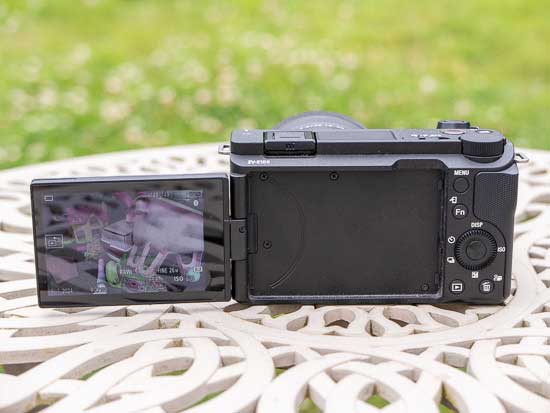
It works very well, creating stable footage when hand-holding and taking out all but the heaviest of footsteps when walking. The catch is that because of the crop, if you are vlogging your face will appear larger when in the frame, so you’ll need to use a pretty wide lens to compensate. We would suggest only using this mode when walking or zooming in to show something, and when presenting to camera stick to using the lens’ stabilisation mode.
In addition, camera-shake metadata is recorded by the ZV-E10 II’s built-in gyro sensor, allowing handheld footage to be smoothed out and stabilised in post-production using Sony’s Catalyst Browse / Catalyst Prepare desktop application.
The ZV-E10 II offers the same burst shooting rates as the original, with both cameras capable of shooting at 11fps using the mechanical shutter and 8fps using the electronic shutter with continuous AF/AE metering and almost no perceptible lag on the LCD screen.
The Sony ZV-E10 II uses the latest menu design from the Alpha A7-series cameras, rather than the one found on earlier models. It has a more logical structure, although as is traditionally the way with Sony’s menu, it’s still pretty complicated.
Usefully the option to customise the Function Button Quick menu remains, and there are two different versions depending on whether you are shooting stills or video.
There is also the MyMenu screen, where you can add any other the Menu settings to your own personalised Menu Screen, and also the option to make this the default screen that pops up when the Menu button is pressed. So although there is an almost overwhelming amount of features in the ZV-E10 II, between the Function Menu and the My Menu you should be able to access everything you need relatively quickly and efficiently.
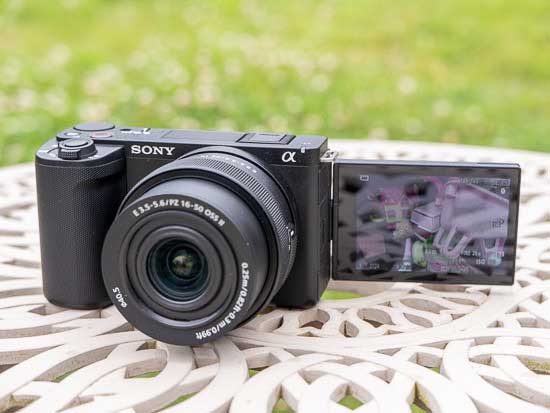
On the side of the ZV-1 are four external ports – HDMI, USB-C and those all important 3.5mm microphone and headphone inputs – housed under two separate unmarked flaps.
The HDMI-out allows for external video recording which will allow you to squeeze every bit of detail out of the APS-C sensor, although attaching any external device kind of defeats the point of this being a small vlogging camera. Still, it is a useful option to have if only to playback video or images directly from the camera.
The USB-C port allows for power to be supplied to both keep the ZV-10 II going with a battery installed, or to charge the battery when the camera is not in use. It’s still an extremely useful feature despite the move to the larger Z-series batteries and those planning to shoot video would be advised to purchase a few, or having a USB battery on standby.
Finally, there’s the memory card slot, which unlike the previous model is no longer incorporated into the battery compartment, but is now housed in the left-hand side of the camera when looking from the rear, a markedly better solution particularly for tripod users.
The new ZV10 II has the same hybrid autofocus system with phase detection and and contrast detections points as its predecessor, but with more points, greater frame coverage, and greater low-light sensitivity.
On the new version there are 759 phase-detection points and 25 contrast points that cover 94% of the frame, with the system working all the way down to -3EV low-light, exactly the same as the A6700.
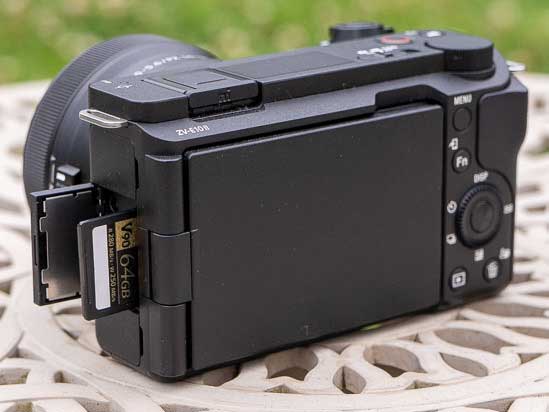
On the previous version there were 425 phase-detection points and 425 contrast points that covered 84% of the frame, with the system only working down to -2EV low-light.
Unfortunately, unlike the A6700, Sony have not added an AI deep learning processing unit to the new ZV-E10 II camera, so it can still only recognise the eye and face of a human, and the eye of an animal.
As well as humans and animals, the A6700 also has the ability to recognise airplanes, cars, trains and insects. The ZVE10 II cannot recognise any of these subjects due to the lack of an AI chip.
Eye AF detects a human eye not only when shooting still images, but also when shooting video, and it works extremely well. It is visibly fast enough to follow an eye around the screen, and you can select which eye you wish to focus on, just like on recent A7 cameras.
AI-based object recognition is used to detect and track the subject, improving the accuracy, speed, and performance of the continuous AF system. You simply select the the Tracking AF mode, position the AF point over the subject that you want to track, half-press the shutter, and the camera will doggedly follow that subject wherever it moves in the frame. It doesn’t have to be a person – the ZV-E10 II will track virtually any subject that you care to point it at.
This also effectively means that you don’t have to activate Eye AF by holding down a custom button (although you still can if you want to). Instead simply half-pressing the shutter button whilst in the Tracking AF mode activates Eye AF automatically if it detects a face/eye, and it seamlessly switches back to non-specific subject tracking if the eye or face can’t be detected, then back again when it can.
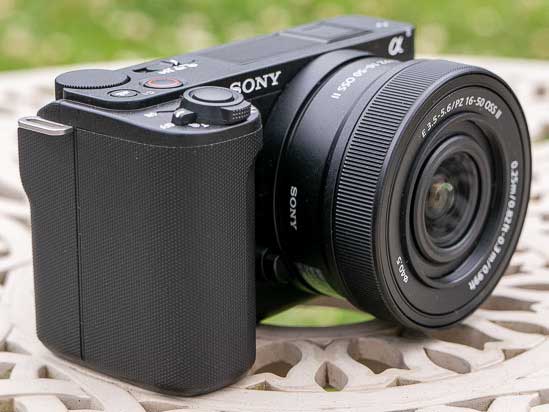
Conversely, you can use the system for easier composition of still subjects too. Simply focus on your subject, hold down the shutter button, and the camera will accurately lock onto your chosen subject while you recompose the frame, even if it’s in one of the furthest corners.
When turned on, the Face-Priority in Multi Metering option adjusts the exposure to ensure that the detected face is exposed for correctly, which is perfect for scenes with very bright background conditions where typically the main subject would be under-exposed and too dark.
The ZV-E10 II can capture oversampled 4K from 6K at up to 60p with a 1.1x crop. Video can be captured in 10-bit 4:2:2 or 4:2:0 in either H.265 or H.264 AVC files. The Slow and Quick motion mode offers up to 5x slow-motion recording at FHD/120fps quality and 2.5x at 4K/60fps.
Sony’s S-Log 3 and S-Cinetone gamma curves enable it to record greater dynamic range, providing you’re prepared to colour-grade the recording in post-production, plus you can now import and display your own LUTs, a feature that has trickled down from the ZV-E1. There’s also the option of recording in HLG (Hybrid Log Gamma) so that you can shoot HDR-ready footage for playback on your compatible TV directly in-camera.
Proxy recording is also available, allowing low resolution 1280 x 720 resolution footage to be recorded alongside 4K or Full HD footage. This is great for those who may be editing video on older computers. Simply edit using the lower resolution proxy files, then switch to the full resolution 4K files when it comes to the fine-tuning and export.

A recording lamp (tally light) is also provided on the front face of the ZV-E10 II’s body for an at-a-glance indication of the current video recording status, and a red color recording alert square is displayed on the LCD screen too (both can be turned off).
Other new video features offered by the ZV-E10 II include Breathing Compensation, which eliminates the small change in the field of view when changing the focus point from near to infinity, and the CineVlog mode.
This new video mode allows you to choose from a range of different cinematic Looks and Moods and combine them in your own particular style. The resulting video is automatically shot in the widescreen Cinemascope aspect ratio (2.35:1) at 24fps with black bands above and below the image for a true cinematic feel, all by simply selecting the Cinematic Vlog option.
Live streaming is possible directly from the ZV-E10 II simply by connecting it to a computer or compatible mobile device via USB, eliminating the need for a video capture card. This allows the camera’s video and audio capabilities to be used for live social media and video conferencing. Both the UVC and UAC standards are supported for improved picture and sound quality during streaming.
A feature that is still unfortunately missing from the ZV-E10 II is an internal ND filter. On the ZV-1, this 3EV filter helps you to shoot at larger apertures on bright days, which is extremely useful when shooting video and trying to stick to the shutter speed being double the frame rate rule. On the ZV-E10 II you’ll need to use actual glass filters mounted on the lens to get the same results.
Image Quality
All of the sample images in this review were taken using the 26 megapixel Extra Fine JPEG setting, which produces an average image size of around 13Mb.
The ZV-E10 II generates impressively clean results with minimal grain and detail loss. At ISO 6400 there’s only a slight increase in noise and reduction in detail, making this sensitivity completely usable.
Only at ISO 12800 does grain and detail smoothing become more severe, although it’s by no means unsightly. ISO 25600 is really the ceiling for acceptable image quality, such is the high level of grain, loss of detail and reduced dynamic range. ISOs 51200 and 102400 are best avoided due to the intrusive grain and colour speckling.
If you dial things down to more sensible sensitivities, though, the ZV-E10 II records excellent dynamic range, especially when assisted by Sony’s Dynamic Range Optimisation. Good colour vibrancy adds extra visual appeal while maintaining accurate colour reproduction, though this of course can be adjusted to your own preference in the camera settings.
Noise
The Sony ZV-E10 II has a standard sensitivity range of ISO 100 to 32000, expandable down to ISO 50 and up to 102400. Auto ISO operates within an ISO 100-6400 range and has selectable upper and lower limits. Two levels of high ISO noise reduction can be selected – Normal, or Low – or the processing can be disabled.
File Quality
Four different JPEG image quality settings available, with Extra Fine being the highest quality option. The ZV-E10 II also supports the HEIF file format with 2 options available. There are 2 different Raw compression settings, with Lossless Compressed being the highest quality option.
| 24M Extra Fine (13.1Mb) (100% Crop) | 24M Fine (5.6Mb) (100% Crop) |
 |  |
| 24M Standard (3.6Mb) (100% Crop) | 24M Light (2.3Mb) (100% Crop) |
 |  |
Dynamic Range Optimizer
D-Range Optimiser (DRO) is Sony’s solution to improve shadow detail in photos taken in contrasty light. There are 5 different levels and an Auto option.
Creative Looks
There are 10 Creative Look preset effects that you can use to change the look of your images which are available when shooting JPEG and/or Raw files.
Picture Profiles
The Sony ZV-E10 II offers a range of 8 Picture Profiles which are available when shooting JPEG and/or Raw files.
Sample Images
This is a selection of sample images from the Sony ZV-E10 II camera, which were all taken using the 26 megapixel Extra Fine JPEG setting. The thumbnails below link to the full-sized versions, which have not been altered in any way.
Sample RAW Images
The Sony ZV-E10 II enables users to capture RAW and JPEG format files. We’ve provided some Sony RAW (ARW) samples for you to download (thumbnail images shown below are not 100% representative).
Sample Movies & Video
This is a sample 4K movie at the quality setting of 3840×2160 pixels.
This is a sample 4K movie at the quality setting of 3840×2160 pixels.
This is a sample 4K movie at the quality setting of 3840×2160 pixels.
This is a sample 4K slow-motion movie at the quality setting of 3840×2160 pixels.
This is a sample 1080p slow-motion movie at the quality setting of 1920×1080 pixels.
Product Images

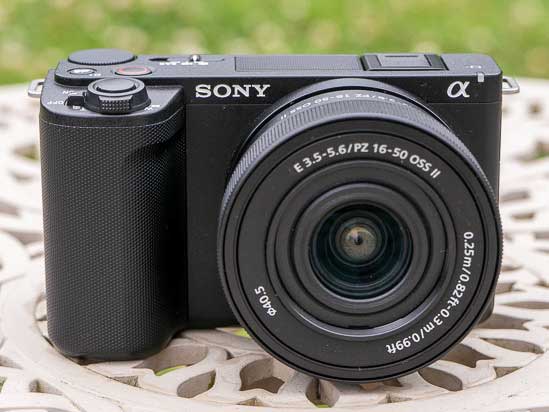
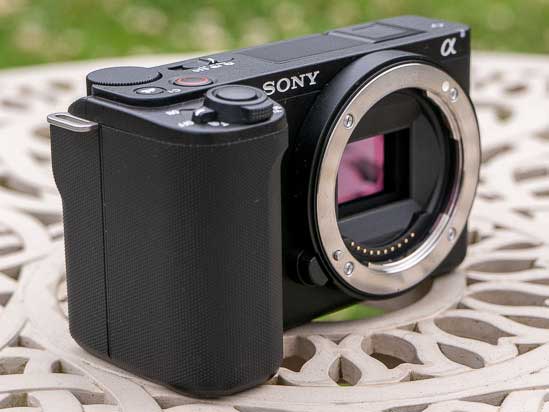

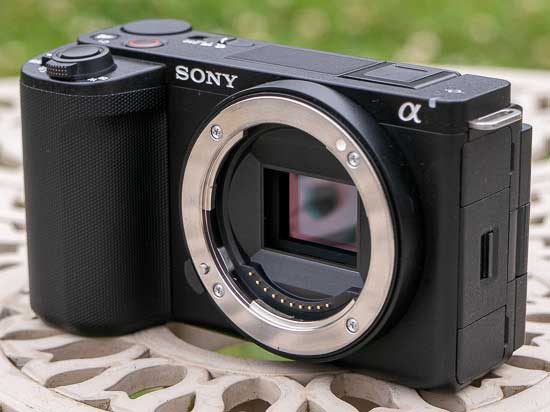

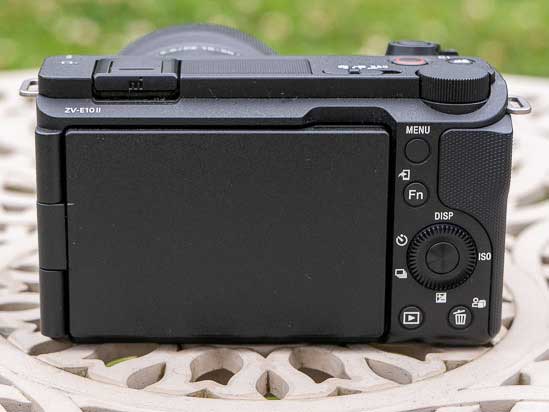
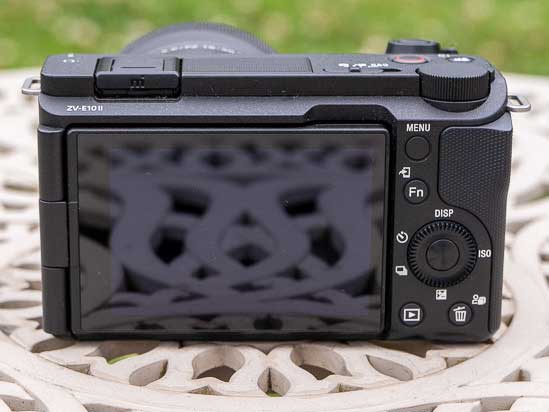


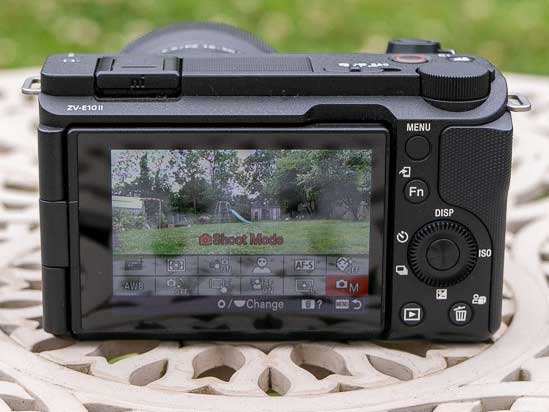
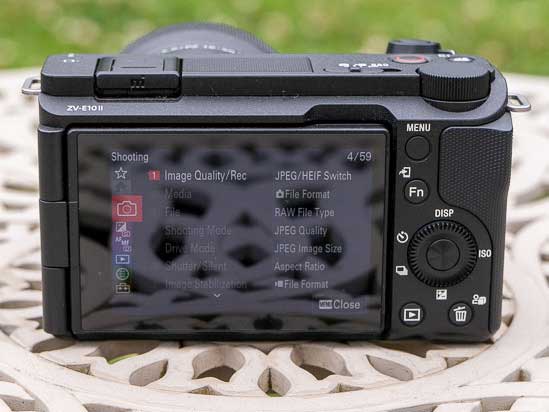
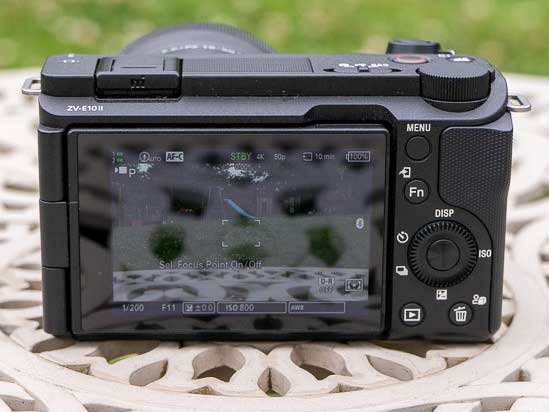




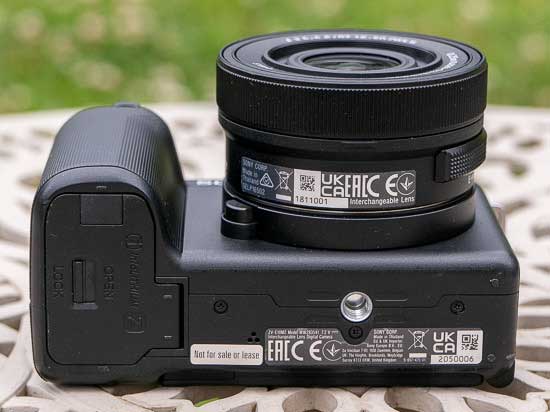
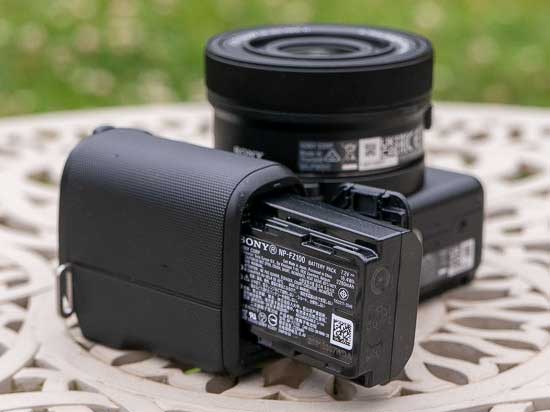
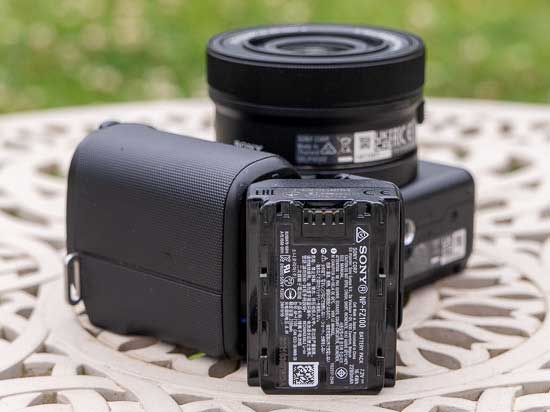

Conclusion
The ZV-E10 II is a rather modest upgrade of the original version from 2021 that addresses some key areas of weakness but markedly neglects others.
Sony have made several key upgrades to the auto-focus system, video quality (4K 10-bit 4.2.2!) and battery life, but strangely haven’t included the subject-recognition AI chip from the A6700, seemingly in order to keep costs down.
With the notable absence of IBIS, a mechanical shutter, an EVF and an ND filter, the ZV-E10 II retains its emphasis on video rather than stills, and on predominantly being used on a tripod or gimbal rather than hand-held.
Although the Active stabilisation mode works pretty well in conjunction with a stabilized lens like the new 16-50mm power zoom, it does introduce a hefty 1.5x or 1.4x crop that requires you to use a wider-angle lens than normal.
The switch to the longer-life Z-series battery and the resulting larger handgrip are both very welcome, as is the relocation of the memory card slot from the battery compartment to the side of the camera and the adoption of the intelligent audio mic from the ZV-1.
Less welcome is the much higher asking price, from £680 / €700 body-only for the ZV-E10 to £950 / €1100 for the Mark II is a rather eye-watering increase that makes the slightly more expensive A6700 more appealing than before.
Overall, the ZV-E10 II offers better auto-focusing, video performance and battery life than the original, but removes the mechanical shutter, costs significantly more at launch and mystifyingly doesn’t include subject-detection, making it somewhat less appealing than its predecessor despite the technological advances on offer.
| Ratings (out of 5) | |
|---|---|
| Design | 4 |
| Features | 4 |
| Ease-of-use | 4 |
| Image quality | 4.5 |
| Value for money | 4 |
Main Rivals
Listed below are some of the rivals of the Sony ZV-E10 II.
The Canon EOS R10 is a tiny new mirrorless camera with an APS-C sensor that can shoot at up to 23fps and record 4K/60p video. Can the R10 compete with the likes of the Fujifilm X-S10, Nikon Z50 and Sony A6400? Find out now by reading our in-depth Canon R10 review…

The Canon EOS R50 is a super-compact mirrorless camera with an APS-C crop sensor that can shoot at 15fps and record 4K/30p video. Can the R50 compete with the likes of the Fujifilm X-S10, Nikon Z30 and Sony ZV-E10? Find out now by reading our in-depth Canon R50 review with full-size sample photos and videos.

The new Z30 is Nikon’s third APS-C cropped-sensor mirrorless camera, following in the footsteps of the Z50 and Z fc models. This time around, though, it’s primarily targeted at vloggers and content creators. Find out what it has to offer by reading our in-depth Nikon Z30 review complete with full-size sample photos and videos…

We’ve kicked off our Panasonic Lumix S9 review with sample JPEG and RAW images, product shots and more…

The A6700 is the new premium model in Sony’s extensive range of APS-C mirrorless cameras, but can it beat both its main rivals and its cheaper siblings? Find out now by reading our in-depth Sony A6700 review, complete with full-size sample images and videos.

The Sony ZV-1 II is a second-generation compact camera designed for vlogging, with a wide-angle zoom lens, vari-angle screen, fast auto-focusing, upgraded three-capsule direction microphone, and special vlogger-friendly shooting modes. Read our in-depth Sony ZV-1 II review with full-size sample photos and videos now…

The Sony ZV-1F is an affordable compact camera aimed at vloggers, with 4K/30p video, a vari-angle screen, a wide-angle lens, and a wealth of vlogger-friendly shooting modes. Should you upgrade from your smartphone to the ZV1F? Read our in-depth Sony ZV-1F review to find out…

The ZV-E1 is Sony’s first vlogging camera to feature a 35mm full-frame sensor, offering 4K/120p recording, 12 megapixel stills, and AI-based autofocusing and stabilisation modes. Is the the ultimate camera for for videos and vlogs? Find out now in our in-depth Sony ZV-E1 review…

The Sony ZV-E10 is a new APS-C sensor mirrorless camera that’s clearly targeted at videographers, with a vari-angle screen, fast auto-focusing, three-capsule direction microphone, and a wealth of vlogger-friendly shooting modes. Is this the ultimate mirrorless camera for aspiring YouTube creators? Read our in-depth Sony ZV-E10 review to find out…
Review Roundup
Reviews of the Sony ZV-E10 II from around the web.
The Sony ZV-E10 II is an immediately attractive package that exudes quality through its ultra-compact, sleek, but sturdy build. The camera shares the same 26MP BSI APS-C sensor as the highly capable A6700 and Sony FX30…
Read the full review »
Specifications
CAMERA TYPE
- Interchangeable lens digital camera
Lens Mount
SENSOR TYPE
- APS-C type (23.3 x 15.5 mm), Exmor R CMOS sensor
NUMBER OF PIXELS (Total)
NUMBER OF PIXELS (EFFECTIVE)
- Still images: Approx. 26.0 megapixels max., Movies: Approx. 19.9 megapixels max.
OPTICAL LOW PASS FILTER
COLOR TEMPERATURE RANGE
Anti-Dust System
RECORDING FORMAT
- JPEG (DCF Ver. 2.0, Exif Ver. 2.32, MPF Baseline compliant), HEIF (MPEG-A MIAF compliant), RAW (Sony ARW 5.0 format compliant)
IMAGE SIZE (PIXELS) [3:2]
- APS-C L: 6192 x 4128 (26 M), M: 4384 x 2920 (13 M), S: 3104 x 2064 (6.4 M)
VIDEO COMPRESSION
- XAVC S: MPEG-4 AVC/H.264, XAVC HS: MPEG-H HEVC/H.265
AUDIO RECORDING FORMAT
- LPCM 2ch (48 kHz 16 bit), LPCM 2ch (48 kHz 24 bit), LPCM 4ch (48 kHz 24 bit)
MOVIE RECORDING FORMAT (XAVC HS 4K)
- 3840 x 2160 (4:2:0, 10bit) (Approx.):59.94p (150 Mbps / 75 Mbps / 45 Mbps), 3840 x 2160 (4:2:0, 10bit) (Approx.):50p (150 Mbps / 75 Mbps / 45 Mbps), 3840 x 2160 (4:2:0, 10bit) (Approx.):23.98p (100 Mbps / 50 Mbps / 30 Mbps), 3840 x 2160 (4:2:2, 10bit) (Approx.):59.94p (200 Mbps / 100 Mbps), 3840 x 2160 (4:2:2, 10bit) (Approx.):50p (200 Mbps / 100 Mbps), 3840 x 2160 (4:2:2, 10bit) (Approx.):23.98p (100 Mbps / 50 Mbps)
MOVIE RECORDING FORMAT (XAVC S 4K)
- 3840 x 2160 (4:2:0, 8bit) (Approx.):59.94p (150 Mbps), 3840 x 2160 (4:2:0, 8bit) (Approx.):50p (150 Mbps), 3840 x 2160 (4:2:0, 8bit) (Approx.):29.97p (100 Mbps / 60 Mbps), 3840 x 2160 (4:2:0, 8bit) (Approx.):25p (100 Mbps / 60 Mbps), 3840 x 2160 (4:2:0, 8bit) (Approx.):23.98p (100 Mbps / 60 Mbps), 3840 x 2160 (4:2:2, 10bit) (Approx.):59.94p (200 Mbps), 3840 x 2160 (4:2:2, 10bit) (Approx.):50p (200 Mbps), 3840 x 2160 (4:2:2, 10bit) (Approx.):29.97p (140 Mbps), 3840 x 2160 (4:2:2, 10bit) (Approx.):25p (140 Mbps), 3840 x 2160 (4:2:2, 10bit) (Approx.):23.98p (100 Mbps)
MOVIE RECORDING FORMAT (XAVC S HD)
- 1920 x 1080 (4:2:0, 8bit) (Approx.):119.88p (100 Mbps / 60 Mbps), 1920 x 1080 (4:2:0, 8bit) (Approx.):100p (100 Mbps / 60 Mbps), 1920 x 1080 (4:2:0, 8bit) (Approx.):59.94p (50 Mbps / 25 Mbps), 1920 x 1080 (4:2:0, 8bit) (Approx.):50p (50 Mbps / 25 Mbps), 1920 x 1080 (4:2:0, 8bit) (Approx.):29.97p (50 Mbps / 16 Mbps), 1920 x 1080 (4:2:0, 8bit) (Approx.):25p (50 Mbps / 16 Mbps), 1920 x 1080 (4:2:0, 8bit) (Approx.):23.98p (50 Mbps), 1920 x 1080 (4:2:2, 10bit) (Approx.):59.94p (50 Mbps), 1920 x 1080 (4:2:2, 10bit) (Approx.):50p (50 Mbps), 1920 x 1080 (4:2:2, 10bit) (Approx.):29.97p (50 Mbps), 1920 x 1080 (4:2:2, 10bit) (Approx.):25p (50 Mbps), 1920 x 1080 (4:2:2, 10bit) (Approx.):23.98p (50 Mbps)
MOVIE RECORDING FORMAT (XAVC S-I 4K)
- 3840 x 2160 (4:2:2, 10bit) (Approx.):59.94p (600 Mbps), 3840 x 2160 (4:2:2, 10bit) (Approx.):50p (500 Mbps), 3840 x 2160 (4:2:2, 10bit) (Approx.):29.97p (300 Mbps), 3840 x 2160 (4:2:2, 10bit) (Approx.):25p (250 Mbps), 3840 x 2160 (4:2:2, 10bit) (Approx.):23.98p (240 Mbps)
MOVIE RECORDING FORMAT (XAVC S-I HD)
- 1920 x 1080 (4:2:2, 10bit) (Approx.):59.94p (222 Mbps), 1920 x 1080 (4:2:2, 10bit) (Approx.):50p (185 Mbps), 1920 x 1080 (4:2:2, 10bit) (Approx.):29.97p (111 Mbps), 1920 x 1080 (4:2:2, 10bit) (Approx.):25p (93 Mbps), 1920 x 1080 (4:2:2, 10bit) (Approx.):23.98p (89 Mbps)
SLOW & QUICK MOTION (SHOOTING FRAME RATE)
PROXY RECORDING
TC / UB
RAW OUTPUT
Memory Card Slot
- Slot for SD (UHS-I/II compliant) memory card
FOCUS TYPE
- Fast Hybrid AF (phase-detection AF / contrast-detection AF)
FOCUS POINT
- Still images: Max. 759 points (phase-detection AF), Movies: Max. 495 points (phase-detection AF)
FOCUS SENSITIVITY RANGE
- EV-3 to EV20 (ISO100 equivalent with F2.0 lens attached)
RECOGNITION TARGET (STILL IMAGES)
RECOGNITION TARGET (MOVIES)
OTHER FEATURES
- AF Level for Crossing. (Still), AF Track for Speed Changes. (Still), AF Subj. Shift Sensitivity (Movie), AF Transition Speed (Movie), Switch V/H AF Area, AF Area Regist., Circ. of Focus Point, Focus Map (Movie), AF Assist (Movie)
AF ILLUMINATOR
METERING TYPE
- 1200-zone evaluative metering
METERING SENSITIVITY
- EV-3 to EV20 (ISO100 equivalent with F2.0 lens attached)
EXPOSURE COMPENSATION
- +/- 5.0 EV (1/3 EV, 1/2 EV steps selectable)
ISO SENSITIVITY
- Still images: ISO 100 – 32000 (expandable to ISO 50 – 102400), AUTO (ISO 100 – 6400, selectable lower limit and upper limit), Movies: ISO 100 – 32000 equivalent, AUTO (ISO 100 – 6400, selectable lower limit and upper limit)
ANTI-FLICKER SHOOT.
TYPE
Monitor Type
- 7.5 cm (3.0-type) type TFT
TOUCH PANEL
Number of Dots
Adjustable Angle
- Opening Angle: Approx. 176 °, Rotation Angle: Approx. 270 °
OTHER FEATURES
- Product Showcase Set, Background Defocus, Soft Skin Effect, Creative Look, Custom function, Picture Profile, Time-lapse, Cinematic Vlog Setting, My Image Style, Vertical Display
CLEAR IMAGE ZOOM (STILL IMAGES)
CLEAR IMAGE ZOOM (MOVIES)
- Approx. 1.5x (4K), Approx. 2x (HD)
Shutter Type
Shutter Speed
- Still images (Electronic shutter): 1/8000 to 30 s, Movies: 1/8000 to 1 s
Flash Sync. Speed
Type
- Still images: Image stabilization supported on lens, Movie: Image stabilization supported on lens (Standard Mode) / Electronic (Active Mode)
Compensation Effect
MODE
- Still images: On / Off, Movie: Active / Standard / Off
TYPE
CONTROL
FLASH COMPENSATION
- +/- 3.0 EV (switchable between 1/3 and 1/2 EV steps)
EXTERNAL FLASH COMPATIBILITY
- Sony α System Flash compatible with Multi Interface Shoe, attach the shoe adaptor for flash compatible with Auto-lock accessory shoe
Continuous Drive Speed (approx. max.)
NO. OF FRAME RECORDABLE (APPROX.)
- JPEG Extra fine L: 143 frames, JPEG Fine L: over 1000 frames, JPEG Standard L: over 1000 frames, RAW: 59 frames, RAW & JPG: 44 frames, RAW (Lossless Compressed): 22 frames, RAW (Lossless Compressed) & JPEG: 17 frames
Pixel Shift Multi Shooting
MODES
- Enlarged display mode, Protect, Rating, Shot Mark (Movie), Divider Frame, Crop, Photo Capture
FUNCTIONS
- Screen Reader, Focus Magnifier, Focus Map (Movie), Peaking Display, Subject Recognition in AF, Touch Focus, Touch Tracking, Touch Shutter, Touch AE, Vari-angle LCD screen, Custom function, Enlarge Menu Screen
PC INTERFACE
USB TYPE-C TERMINAL
- Yes (SuperSpeed USB 5 Gbps (USB 3.2) compatible)
NFC
Sync Terminal
WIRELESS LAN(BUILT-IN)
- Yes (Wi-Fi Compatible, IEEE 802.11a/b/g/n/ac (2.4 GHz band/5 GHz band))[[F_DI0197]][[F_DI0171]]
Bluetooth
- Yes (Bluetooth Standard Ver. 4.2 (2.4 GHz band))
HDMI OUTPUT
- HDMI micro connector (Type-D), 3840 x 2160 (59.94p / 50p / 29.97p / 25p / 23.98p) / 1920 x 1080 (59.94p / 50p / 23.98p) / 1920 x 1080 (59.94i / 50i), YCbCr 4:2:2 10bit / RGB 8bit
Multi Interface Shoe
- Yes (with Digital Audio Interface)
Mic Terminal
- Yes (3.5 mm Stereo minijack)
Headphone Terminal
- Yes (3.5 mm Stereo minijack)
REMOTE CONTROL (WIRELESS)
- Yes (Bluetooth remote control)
LAN Terminal
FUNCTIONS
- Send to smartphone, Remote control via smartphone, Remote Shooting
VIDEO DATA FORMAT
VIDEO RESOLUTION
- 3840 x 2160 (15p / 30p), 3840 x 2160 (12.5p / 25p), 1920 x 1080 (30p / 60p), 1920 x 1080 (25p / 50p), 1280 x 720 (30p), 1280 x 720 (25p)
AUDIO DATA FORMAT
VIDEO DATA FORMAT
- MPEG-4 AVC/H.264, MPEG-H HEVC/H.265
VIDEO RESOLUTION
- 3840 x 2160 (30p), 3840 x 2160 (25p), 2560 x 1440 (30p), 2560 x 1440 (25p), 1920 x 1080 (30p / 60p), 1920 x 1080 (25p / 50p), 1280 x 720 (30p / 60p), 1280 x 720 (25p / 50p)
AUDIO DATA FORMAT
- AAC-LC 2ch (16bit 48 kHz)
PROTOCOL
Microphone
Speaker
SETTING
- Shading, Chromatic Aberration, Distortion, Breathing (Movie)
SUPPLIED BATTERY
- One rechargeable battery pack NP-FZ100
Battery Life (Still Images)
- Approx. 610 shots (LCD monitor) (CIPA standard)
Battery Life (Movie, actual recording)
- Approx. 130 min (LCD monitor) (CIPA standard)
Internal Battery Charge
- Yes (Available with USB Type-C Terminal. USB Power Delivery compatible)
USB POWER SUPPLY
- Yes (Available with USB Type-C Terminal. USB Power Delivery compatible)
Power consumption with LCD screen
- Still images: Approx. 3.2 W (with E PZ 16-50mm F3.5-5.6 OSS II lens attached),Movies: Approx. 5.0 W (with E PZ 16-50mm F3.5-5.6 OSS II lens attached)
BODY ONLY
- Approx. 292 g / Approx. 10.3 oz
Dimensions (W x H x D)
- Approx. 114.8 x 67.5 x 54.2 mm (from grip to monitor)/Approx. 4 5/8 x 2 3/4 x 2 1/4 inches (from grip to monitor)
OPERATING TEMPERATURE
- 0 – 40 ℃ / 32 – 104 °F
WHAT’S IN THE BOX
- Rechargeable Battery NP-FZ100, Shoulder strap, Wind Screen, Wind Screen Adaptor, Body cap
Body + 16-50mm Power Zoom Lens (SELP16502)
ZV-E10M2K
Body + 16-50mm Power Zoom Lens (SELP16502)
ZV-E10M2K
ZV-E10 II vlog camera
CAMERA TYPE
- Interchangeable lens digital camera
Lens Mount
SENSOR TYPE
- APS-C type (23.3 x 15.5 mm), Exmor R CMOS sensor
NUMBER OF PIXELS (Total)
NUMBER OF PIXELS (EFFECTIVE)
- Still images: Approx. 26.0 megapixels max., Movies: Approx. 19.9 megapixels max.
OPTICAL LOW PASS FILTER
COLOR TEMPERATURE RANGE
Anti-Dust System
RECORDING FORMAT
- JPEG (DCF Ver. 2.0, Exif Ver. 2.32, MPF Baseline compliant), HEIF (MPEG-A MIAF compliant), RAW (Sony ARW 5.0 format compliant)
IMAGE SIZE (PIXELS) [3:2]
- APS-C L: 6192 x 4128 (26 M), M: 4384 x 2920 (13 M), S: 3104 x 2064 (6.4 M)
VIDEO COMPRESSION
- XAVC S: MPEG-4 AVC/H.264, XAVC HS: MPEG-H HEVC/H.265
AUDIO RECORDING FORMAT
- LPCM 2ch (48 kHz 16 bit), LPCM 2ch (48 kHz 24 bit), LPCM 4ch (48 kHz 24 bit)
MOVIE RECORDING FORMAT (XAVC HS 4K)
- 3840 x 2160 (4:2:0, 10bit) (Approx.):59.94p (150 Mbps / 75 Mbps / 45 Mbps), 3840 x 2160 (4:2:0, 10bit) (Approx.):50p (150 Mbps / 75 Mbps / 45 Mbps), 3840 x 2160 (4:2:0, 10bit) (Approx.):23.98p (100 Mbps / 50 Mbps / 30 Mbps), 3840 x 2160 (4:2:2, 10bit) (Approx.):59.94p (200 Mbps / 100 Mbps), 3840 x 2160 (4:2:2, 10bit) (Approx.):50p (200 Mbps / 100 Mbps), 3840 x 2160 (4:2:2, 10bit) (Approx.):23.98p (100 Mbps / 50 Mbps)
MOVIE RECORDING FORMAT (XAVC S 4K)
- 3840 x 2160 (4:2:0, 8bit) (Approx.):59.94p (150 Mbps), 3840 x 2160 (4:2:0, 8bit) (Approx.):50p (150 Mbps), 3840 x 2160 (4:2:0, 8bit) (Approx.):29.97p (100 Mbps / 60 Mbps), 3840 x 2160 (4:2:0, 8bit) (Approx.):25p (100 Mbps / 60 Mbps), 3840 x 2160 (4:2:0, 8bit) (Approx.):23.98p (100 Mbps / 60 Mbps), 3840 x 2160 (4:2:2, 10bit) (Approx.):59.94p (200 Mbps), 3840 x 2160 (4:2:2, 10bit) (Approx.):50p (200 Mbps), 3840 x 2160 (4:2:2, 10bit) (Approx.):29.97p (140 Mbps), 3840 x 2160 (4:2:2, 10bit) (Approx.):25p (140 Mbps), 3840 x 2160 (4:2:2, 10bit) (Approx.):23.98p (100 Mbps)
MOVIE RECORDING FORMAT (XAVC S HD)
- 1920 x 1080 (4:2:0, 8bit) (Approx.):119.88p (100 Mbps / 60 Mbps), 1920 x 1080 (4:2:0, 8bit) (Approx.):100p (100 Mbps / 60 Mbps), 1920 x 1080 (4:2:0, 8bit) (Approx.):59.94p (50 Mbps / 25 Mbps), 1920 x 1080 (4:2:0, 8bit) (Approx.):50p (50 Mbps / 25 Mbps), 1920 x 1080 (4:2:0, 8bit) (Approx.):29.97p (50 Mbps / 16 Mbps), 1920 x 1080 (4:2:0, 8bit) (Approx.):25p (50 Mbps / 16 Mbps), 1920 x 1080 (4:2:0, 8bit) (Approx.):23.98p (50 Mbps), 1920 x 1080 (4:2:2, 10bit) (Approx.):59.94p (50 Mbps), 1920 x 1080 (4:2:2, 10bit) (Approx.):50p (50 Mbps), 1920 x 1080 (4:2:2, 10bit) (Approx.):29.97p (50 Mbps), 1920 x 1080 (4:2:2, 10bit) (Approx.):25p (50 Mbps), 1920 x 1080 (4:2:2, 10bit) (Approx.):23.98p (50 Mbps)
MOVIE RECORDING FORMAT (XAVC S-I 4K)
- 3840 x 2160 (4:2:2, 10bit) (Approx.):59.94p (600 Mbps), 3840 x 2160 (4:2:2, 10bit) (Approx.):50p (500 Mbps), 3840 x 2160 (4:2:2, 10bit) (Approx.):29.97p (300 Mbps), 3840 x 2160 (4:2:2, 10bit) (Approx.):25p (250 Mbps), 3840 x 2160 (4:2:2, 10bit) (Approx.):23.98p (240 Mbps)
MOVIE RECORDING FORMAT (XAVC S-I HD)
- 1920 x 1080 (4:2:2, 10bit) (Approx.):59.94p (222 Mbps), 1920 x 1080 (4:2:2, 10bit) (Approx.):50p (185 Mbps), 1920 x 1080 (4:2:2, 10bit) (Approx.):29.97p (111 Mbps), 1920 x 1080 (4:2:2, 10bit) (Approx.):25p (93 Mbps), 1920 x 1080 (4:2:2, 10bit) (Approx.):23.98p (89 Mbps)
SLOW & QUICK MOTION (SHOOTING FRAME RATE)
PROXY RECORDING
TC / UB
RAW OUTPUT
Memory Card Slot
- Slot for SD (UHS-I/II compliant) memory card
FOCUS TYPE
- Fast Hybrid AF (phase-detection AF / contrast-detection AF)
FOCUS POINT
- Still images: Max. 759 points (phase-detection AF), Movies: Max. 495 points (phase-detection AF)
FOCUS SENSITIVITY RANGE
- EV-3 to EV20 (ISO100 equivalent with F2.0 lens attached)
RECOGNITION TARGET (STILL IMAGES)
RECOGNITION TARGET (MOVIES)
OTHER FEATURES
- AF Level for Crossing. (Still), AF Track for Speed Changes. (Still), AF Subj. Shift Sensitivity (Movie), AF Transition Speed (Movie), Switch V/H AF Area, AF Area Regist., Circ. of Focus Point, Focus Map (Movie), AF Assist (Movie)
AF ILLUMINATOR
METERING TYPE
- 1200-zone evaluative metering
METERING SENSITIVITY
- EV-3 to EV20 (ISO100 equivalent with F2.0 lens attached)
EXPOSURE COMPENSATION
- +/- 5.0 EV (1/3 EV, 1/2 EV steps selectable)
ISO SENSITIVITY
- Still images: ISO 100 – 32000 (expandable to ISO 50 – 102400), AUTO (ISO 100 – 6400, selectable lower limit and upper limit), Movies: ISO 100 – 32000 equivalent, AUTO (ISO 100 – 6400, selectable lower limit and upper limit)
ANTI-FLICKER SHOOT.
TYPE
Monitor Type
- 7.5 cm (3.0-type) type TFT
TOUCH PANEL
Number of Dots
Adjustable Angle
- Opening Angle: Approx. 176 °, Rotation Angle: Approx. 270 °
OTHER FEATURES
- Product Showcase Set, Background Defocus, Soft Skin Effect, Creative Look, Custom function, Picture Profile, Time-lapse, Cinematic Vlog Setting, My Image Style, Vertical Display
CLEAR IMAGE ZOOM (STILL IMAGES)
CLEAR IMAGE ZOOM (MOVIES)
- Approx. 1.5x (4K), Approx. 2x (HD)
Shutter Type
Shutter Speed
- Still images (Electronic shutter): 1/8000 to 30 s, Movies: 1/8000 to 1 s
Flash Sync. Speed
Type
- Still images: Image stabilization supported on lens, Movie: Image stabilization supported on lens (Standard Mode) / Electronic (Active Mode)
Compensation Effect
MODE
- Still images: On / Off, Movie: Active / Standard / Off
TYPE
CONTROL
FLASH COMPENSATION
- +/- 3.0 EV (switchable between 1/3 and 1/2 EV steps)
EXTERNAL FLASH COMPATIBILITY
- Sony α System Flash compatible with Multi Interface Shoe, attach the shoe adaptor for flash compatible with Auto-lock accessory shoe
Continuous Drive Speed (approx. max.)
NO. OF FRAME RECORDABLE (APPROX.)
- JPEG Extra fine L: 143 frames, JPEG Fine L: over 1000 frames, JPEG Standard L: over 1000 frames, RAW: 59 frames, RAW & JPG: 44 frames, RAW (Lossless Compressed): 22 frames, RAW (Lossless Compressed) & JPEG: 17 frames
Pixel Shift Multi Shooting
MODES
- Enlarged display mode, Protect, Rating, Shot Mark (Movie), Divider Frame, Crop, Photo Capture
FUNCTIONS
- Screen Reader, Focus Magnifier, Focus Map (Movie), Peaking Display, Subject Recognition in AF, Touch Focus, Touch Tracking, Touch Shutter, Touch AE, Vari-angle LCD screen, Custom function, Enlarge Menu Screen
PC INTERFACE
USB TYPE-C TERMINAL
- Yes (SuperSpeed USB 5 Gbps (USB 3.2) compatible)
NFC
Sync Terminal
WIRELESS LAN(BUILT-IN)
- Yes (Wi-Fi Compatible, IEEE 802.11a/b/g/n/ac (2.4 GHz band/5 GHz band))[[F_DI0197]][[F_DI0171]]
Bluetooth
- Yes (Bluetooth Standard Ver. 4.2 (2.4 GHz band))
HDMI OUTPUT
- HDMI micro connector (Type-D), 3840 x 2160 (59.94p / 50p / 29.97p / 25p / 23.98p) / 1920 x 1080 (59.94p / 50p / 23.98p) / 1920 x 1080 (59.94i / 50i), YCbCr 4:2:2 10bit / RGB 8bit
Multi Interface Shoe
- Yes (with Digital Audio Interface)
Mic Terminal
- Yes (3.5 mm Stereo minijack)
Headphone Terminal
- Yes (3.5 mm Stereo minijack)
REMOTE CONTROL (WIRELESS)
- Yes (Bluetooth remote control)
LAN Terminal
FUNCTIONS
- Send to smartphone, Remote control via smartphone, Remote Shooting
VIDEO DATA FORMAT
VIDEO RESOLUTION
- 3840 x 2160 (15p / 30p), 3840 x 2160 (12.5p / 25p), 1920 x 1080 (30p / 60p), 1920 x 1080 (25p / 50p), 1280 x 720 (30p), 1280 x 720 (25p)
AUDIO DATA FORMAT
VIDEO DATA FORMAT
- MPEG-4 AVC/H.264, MPEG-H HEVC/H.265
VIDEO RESOLUTION
- 3840 x 2160 (30p), 3840 x 2160 (25p), 2560 x 1440 (30p), 2560 x 1440 (25p), 1920 x 1080 (30p / 60p), 1920 x 1080 (25p / 50p), 1280 x 720 (30p / 60p), 1280 x 720 (25p / 50p)
AUDIO DATA FORMAT
- AAC-LC 2ch (16bit 48 kHz)
PROTOCOL
Microphone
Speaker
SETTING
- Shading, Chromatic Aberration, Distortion, Breathing (Movie)
SUPPLIED BATTERY
- One rechargeable battery pack NP-FZ100
Battery Life (Still Images)
- Approx. 610 shots (LCD monitor) (CIPA standard)
Battery Life (Movie, actual recording)
- Approx. 130 min (LCD monitor) (CIPA standard)
Internal Battery Charge
- Yes (Available with USB Type-C Terminal. USB Power Delivery compatible)
USB POWER SUPPLY
- Yes (Available with USB Type-C Terminal. USB Power Delivery compatible)
Power consumption with LCD screen
- Still images: Approx. 3.2 W (with E PZ 16-50mm F3.5-5.6 OSS II lens attached),Movies: Approx. 5.0 W (with E PZ 16-50mm F3.5-5.6 OSS II lens attached)
BODY ONLY
- Approx. 292 g / Approx. 10.3 oz
Dimensions (W x H x D)
- Approx. 114.8 x 67.5 x 54.2 mm (from grip to monitor)/Approx. 4 5/8 x 2 3/4 x 2 1/4 inches (from grip to monitor)
OPERATING TEMPERATURE
- 0 – 40 ℃ / 32 – 104 °F
WHAT’S IN THE BOX
- SELP16502, Rechargeable Battery NP-FZ100, Shoulder strap, Wind Screen, Wind Screen Adaptor, Lens cap
Your Comments
Credit : Source Post



